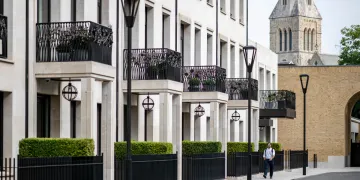Chelsea has long been associated with elegance, sophistication and architectural grandeur. Its townhouses in particular stand as a testament to the area’s transformation from a rural riverside retreat to one of the most desirable residential areas in the capital. The history of Chelsea’s townhouses is intrinsically linked to the broader development of London, reflecting the changes in architectural styles, social structures and the urban planning over the centuries.
Early Development
Chelsea’s reputation as a residential haven dates back to the 16th century when it became a favoured retreat for royalty and aristocracy. The presence of Sir Thomas More’s estate and later the construction of Chelsea Old Church in the early 1500s cemented the area’s status as a distinguished enclave. However, it was not until the 17th century that townhouses, as they would later be recognised, began to emerge.
During this period, Chelsea was still semi-rural, characterised by large estates and gardens. The construction of grand houses along the river, such as Lindsey House (1674), showcased the early transition towards more compact, urban-style dwellings. These properties followed the classical Palladian style, reflecting the architectural trends of the time, with symmetrical facades, red brick exteriors and elegant sash windows.
Georgian Expansion: 18th Century
The 18th century saw a significant expansion of Chelsea’s townhouses as London grew in both population and affluence. The Georgian period introduced a more uniform and structured approach to townhouse design. Developers such as Sir Hans Sloane, who had acquired large portions of Chelsea, played a crucial role in transforming the district into a fashionable residential area.
Georgian townhouses in Chelsea were typically constructed as terraced houses, featuring three to four storeys with a restrained yet elegant design. Stuccoed facades became more common in the later years of the period and the use of wrought iron railings, fanlights above doorways and proportional window placements were distinctive features. Many of these townhouses were built along new streets such as Cheyne Walk, which remains one of Chelsea’s most prestigious addresses to this day.
Victorian and Edwardian Refinements: 19th and Early 20th Century
By the Victorian era, Chelsea had fully integrated into London’s urban fabric, attracting a mix of wealthy residents, bohemian artists and writers. The 19th century saw an evolution in townhouse architecture, with the Victorian style incorporating more ornate detailing, bay windows and decorative brickwork. Areas such as Tite Street became known for their artistic community, with figures like Oscar Wilde residing in the area.
The development of Cadogan Square and the surrounding streets in the late 19th century further defined Chelsea’s townhouse aesthetic. These buildings, often with red brick facades and intricate terracotta detailing, reflected the Queen Anne Revival style that became popular during this period. By the Edwardian era, townhouses had become even more refined, featuring grander proportions, larger windows and more intricate plasterwork.

Modern Adaptations and Preservation
The 20th and 21st centuries have seen a shift in the function and adaptation of Chelsea’s townhouses. While many of the historic buildings have been preserved and restored, some have been repurposed into apartments, boutique hotels and commercial spaces. Strict conservation regulations ensure that the architectural integrity of these buildings is maintained, allowing Chelsea’s streetscapes to retain their historic charm.
A prime example of honouring Chelsea’s architectural history is the Chelsea Barracks development. This prestigious residential project has been carefully designed to complement the area’s rich heritage while integrating modern luxury. The development incorporates traditional materials such as Portland stone and brickwork, echoing the Georgian and Victorian townhouses that characterise the district. Landscape design and public spaces have also been sensitively planned to maintain Chelsea’s historical ambiance, ensuring that the site blends seamlessly with its surroundings.
Today, Chelsea’s townhouses continue to be some of the most sought-after properties in London. Their combination of historical character, prime location and timeless elegance makes them highly desirable among affluent buyers. The district’s blend of past and present ensures that Chelsea remains a symbol of London’s architectural heritage, where centuries-old townhouses stand as enduring monuments to the city’s evolution.


